
The basic thrust
of monetary policy remained geared towards creating an appropriate environment
for sustained growth through stable prices and exchange rates. The Reserve Money Programme and liquidity-forecasting
framework of the Bank as well as the implementation of appropriate policies
based on those forecasts helped to contain the upside risks to inflation. As mentioned, the rate of inflation came down
to 5.3 per cent in 1999-00 from 7.9 per cent in 1998-99. There was a marginal slowdown in the growth
rate of domestic credit but an appreciable reduction in central bank claims on
the Government during the fiscal year 1999-00.
Monetary expansion slowed down in the context of a falling rate of
output due essentially to the drought affecting the sugar sector.
The year 1999-00 was also marked by the introduction of a new blend of instruments designed to give a further edge to indirect monetary management. In December 1999, the Bank introduced the use of repurchase transactions and provided a standing borrowing facility to commercial banks. This package of measures has had the effect of enhancing liquidity management by the system while also developing active interbank and secondary security market activities. An improved functioning of the money and foreign exchange markets emerged in this context.
Stronger market confidence was reflected in an unprecedented rise in the net foreign assets of the Bank of Mauritius, which reached a peak of nearly Rs19 billion, with the result that the net international reserves of the country stood above Rs26 billion at the end of January 2000, or over US$1 billion.
Repurchase Transactions
As its main mechanism for managing short-term liquidity fluctuations in the domestic money market, the Bank of Mauritius started, with effect from 15 December 1999, to conduct at its own initiative in between weekly auctions of Treasury Bills, short-term repurchase transactions (repos) and reverse repurchase transactions (reverse repos). This measure aims at promoting efficient liquidity management in the market between two weekly Treasury Bill auctions. Both repos and reverse repos are conducted through an auctioning process under the umbrella of a Master Repurchase Agreement between the Bank and all commercial banks. The Bank is currently entering into repurchase agreements exclusively with commercial banks in order to adapt the market to this new instrument. Eventually, the list of eligible counterparties may be extended to include other institutions.
Lombard
Facility
The Bank introduced, as from 15 December 1999, a standing facility, known as the Lombard Facility, to provide overnight collateralized advances to commercial banks. This facility is operated at the initiative of commercial banks themselves, thereby giving them the necessary means and confidence to engage actively in the treasury management function, such as engaging in repurchase transactions. Each commercial bank is able to draw down part or the full amount of the facility allocated to it in order to meet unexpected funding shortfalls on an overnight basis. For this purpose, commercial banks assign a specified amount of eligible Government securities, which are either Treasury Bills or other bonds acceptable to the central bank as collateral, whenever they resort to the Lombard Facility.
The rate payable for use of this facility, the Lombard Rate, is used as a signalling mechanism for the Bank's monetary policy stance. The rate was initially set at 14.00 per cent per annum. It was reduced to 13.00 per cent per annum on 22 March 2000 against a background of a falling rate of domestic inflation, and further down to 11.50 per cent on 20 June 2000. Banks adjusted their interest rates correspondingly.
Rediscounting
of export bills
The Bank also provided, with effect from 3 March 2000, rediscount facilities to commercial banks with respect to EPZ export bills denominated in euro and euro zone currencies with a remaining life to maturity not exceeding 90 days. The objective of that measure was to provide relief to the EPZ by offsetting some of the adverse impact of the movement in the exchange rate of the euro on their exports to the European Union. Simultaneously, the Bank put in place a mechanism to neutralise the liquidity so injected in the market. Initially, the rediscount rate was set at 7.5 per cent per annum, with commercial banks discounting those bills at 9.5 per cent per annum. In line with the reduction in the Lombard Rate in March 2000, the rate was reduced to 6.5 per cent per annum, with banks' discount rate at 8.5 per cent per annum. The facility was discontinued with effect from 1 July 2000.
Monetary
Aggregates
Net foreign assets of the banking system increased by Rs2,622 million, or 11.9 per cent, from Rs22,087 million at the end of June 1999 to Rs24,709 million at the end of June 2000, as compared to a rise of 4.6 per cent in 1998-99. Net foreign assets of the Bank of Mauritius rose by Rs2,140 million, or 14.0 per cent, from Rs15,315 million at the end of June 1999 to Rs17,455 million at the end of June 2000, higher than the increase of 3.0 per cent recorded in 1998-99. Net foreign assets of commercial banks went up by Rs482 million, or 7.1 per cent, from Rs6,772 million at the end of June 1999 to Rs7,254 million at the end of June 2000 as compared to a rise of 8.4 per cent recorded in 1998-99.
Total domestic credit increased by Rs9,729 million, or 12.7 per cent, from Rs76,727 million at the end of June 1999 to Rs86,456 million at the end of June 2000, slightly lower than the rise of 13.0 per cent noted in 1998-99.
Net credit to Government went up by Rs2,452 million, or 15.3 per cent, from Rs16,014 million at the end of June 1999 to Rs18,466 million at the end of June 2000, as against a drop of 7.7 per cent recorded in 1998-99. Net credit to Government from the Bank of Mauritius fell by Rs1,575 million, or 34.4 per cent, from Rs4,577 million at the end of June 1999 to Rs3,002 million at the end of June 2000 as against an expansion of 86.5 per cent in 1998-99. Net credit to Government from commercial banks went up by Rs4,027 million, or 35.2 per cent, from Rs11,437 million at the end of June 1999 to Rs15,464 million at the end of June 2000 as against a fall of 23.3 per cent in 1998-99.

Commercial banks'
credit to the private sector went up by Rs7,165 million, or 11.9 per cent, from
Rs60,106 million at the end of June 1999 to Rs67,271 million at the end of June
2000 compared to a higher increase of 20.4 per cent recorded in 1998-99. Loans and advances increased by Rs5,286
million, or 10.6 per cent, from Rs50,082 million at the end of June 1999 to
Rs55,368 million at the end of June 2000 compared to the rise of 16.7 per cent
recorded in 1998-99. Commercial banks'
investments in shares and debentures of the private sector rose by Rs1,879
million, or 18.7 per cent, compared to an increase of 42.5 per cent in 1998-99.

Broad money
supply M2 went up by Rs8,731 million, or 10.9 per cent, from Rs80,204 million
at the end of June 1999 to Rs88,935 million at the end of June 2000, lower than
the increase of 13.2 per cent noted in 1998-99. Both components of M2, namely money supply M1 and quasi-money,
registered increases.
Money supply M1 rose by Rs159 million, or 1.5 per cent, from Rs10,906 million at the end of June 1999 to Rs11,065 million at the end of June 2000, lower than the growth of 7.4 per cent recorded in 1998-99. Demand deposits, one of the components of M1, declined by Rs136 million, or 2.3 per cent, from Rs6,030 million at the end of June 1999 to Rs5,894 million at the end of June 2000 as against an increase of 9.6 per cent in 1998-99. Currency with public, the other component of M1, went up by Rs296 million, or 6.1 per cent, from Rs4,876 million at the end of June 1999 to Rs5,172 million at the end of June 2000, higher than the growth of 4.8 per cent in 1998-99.



Quasi-money rose
by Rs8,571 million, or 12.4 per cent, from Rs69,298 million at the end of June
1999 to Rs77,869 million at the end of June 2000 compared to a higher increase
of 14.1 per cent in 1998-99. Savings deposits
went up by Rs3,871 million, or 12.2 per cent, from Rs31,831 million at the end
of June 1999 to Rs35,702 million at the end of June 2000, slightly lower than
the growth of 12.7 per cent recorded in 1998-99. Time deposits increased by Rs3,700 million, or 12.2 per cent,
from Rs30,239 million at the end of June 1999 to Rs33,939 million at the end of
June 2000, lower than the growth of 15.3 per cent noted in 1998-99. Foreign currency deposits rose by Rs999
million, or 13.8 per cent, from Rs7,229 million at the end of June 1999 to
Rs8,228 million at the end of June 2000, lower than the increase of 15.7 per
cent recorded in 1998-99.
Chart III.1 shows
the evolution of real GDP growth, inflation rate and growth of money supply M2
since 1995-96. Tables III.1, III.2 and
III.3, and Chart II.2 give details on the evolution of monetary aggregates.
Reserve Money

Reserve money
fell by Rs579 million, or 5.6 per cent, from Rs10,345 million at the end of
June 1999 to Rs9,766 million at the end of June 2000, as against an increase of
20.5 per cent in 1998-99. The drop in
net credit to Government from the Bank of Mauritius offset, to a large extent,
the impact of the rise in the net foreign assets of the Bank of Mauritius on reserve
money.

Of the components of reserve money, currency with public rose by Rs296 million, or 6.1 per cent, from Rs4,876 million at the end of June 1999 to Rs5,172 million at the end of June 2000 compared to a lower rise of 4.8 per cent in 1998-99. Currency in commercial banks' vaults went down by Rs443 million, or 22.1 per cent, from Rs2,000 million at the end of June 1999 to Rs1,557 million at the end of June 2000 as against a rise of 44.5 per cent in the preceding fiscal year. Demand deposits held with the Bank of Mauritius dropped by Rs432 million, or 12.5 per cent, from Rs3,469 million at the end of June 1999 to Rs3,037 million at the end of June 2000 in contrast to an increase of 36.2 per cent in 1998-99.
On the sources side, net foreign assets of the Bank of Mauritius expanded by Rs2,140 million, or 14.0 per cent, from Rs15,315 million at the end of June 1999 to Rs17,455 million at the end of June 2000 compared to a lower increase of 3.0 per cent in 1998-99. Net central bank credit to Government contracted by Rs1,575 million, or 34.4 per cent, from Rs4,577 million at the end of June 1999 to Rs3,002 million at the end of June 2000 as against an increase of 86.5 per cent in 1998-99. Bank of Mauritius credit to non-bank financial institutions went down by Rs140 million, or 24.3 per cent, from Rs575 million at the end of June 1999 to Rs435 million at the end of June 2000 as against a growth of 20.7 per cent in 1998-99.
Table III.4 and Chart III.3 give details on the components and sources of reserve money from end-June 1996 to end-June 2000.
Trends in Reserve Money and Monetary
Ratios
The monthly average level of reserve money went up by 3.3 per cent, from Rs9,454 million in 1998-99 to Rs9,765 million in 1999-00, lower than the increase of 9.4 per cent recorded in 1998-99.
The monthly average level of aggregate monetary resources, money supply M2, increased by 13.7 per cent, from Rs75,184 million in 1998-99 to Rs85,448 million in 1999-00, higher than the rise of 11.7 per cent noted in 1998-99. There was a marked deceleration in the rate of growth of the monthly average level of money supply M1, while the rate of growth of the monthly average level of quasi-money was above its previous fiscal year's level.
The monthly average level of money supply M1 rose marginally by 0.4 per cent, from Rs10,615 million in 1998-99 to Rs10,654 million in 1999-00, much lower than the increase of 8.4 per cent recorded in 1998-99. The monthly average level of currency with public declined by 0.2 per cent, from Rs5,026 million in 1998-99 to Rs5,018 million in 1999-00 compared to the rise of 6.4 per cent noted in 1998-99. The monthly average level of demand deposits went up from Rs5,589 million in 1998-99 to Rs5,637 million in 1999-00, or by 0.1 per cent, lower than the rise of 10.3 per cent recorded in 1998-99.
The monthly average level of quasi-money expanded by 15.8 per cent, from Rs64,569 million in 1998-99 to Rs74,794 million in 1999-00, higher than the increase of 12.3 per cent recorded in 1998-99.
The average money multiplier for money supply M1 fell from 1.12 in 1998-99 to 1.09 in 1999-00. That for money supply M2 went up from 7.96 to 8.75 over the same period due to the larger increase in average money supply M2 relative to average reserve money.
The ratio of currency with public to money supply M1 went down slightly from 47.3 per cent in 1998-99 to 47.1 per cent in 1999-00. Consequently, the ratio of demand deposits to money supply improved from 52.7 per cent in 1998-99 to 52.9 per cent in 1999-00. The ratio of currency with public to money supply M2 dropped from 6.7 per cent in 1998-99 to 5.9 per cent in 1999-00, while that of demand deposits to money supply M2 fell from 7.4 per cent to 6.6 per cent over the same period. The ratio of money supply M1 to money supply M2 went down from 14.1 per cent in 1998-99 to 12.5 per cent in 1999-00. Thus, the ratio of quasi-money to money supply M2 went up from 85.9 per cent to 87.5 per cent over the same period due to both a slower increase of money supply M1 and an acceleration of the rate of growth of savings and time deposits.
Table III.5 gives
details on monetary ratios for the years ended June 1996 through June 2000

Income Velocity of Circulation of Money

The income
velocity of circulation of currency maintained its upward trend, increasing to
16.20 in 1999-00, from 15.19 in 1998-99.
The income velocity of circulation of money supply M1 rose for the
second consecutive year, from 9.61 in 1998-99 to 10.66 in 1999-00. The income velocity of circulation of money
supply M2 maintained the downward trend noted since 1997-98, falling from 1.36
in 1998-99 to 1.33 in 1999-00.
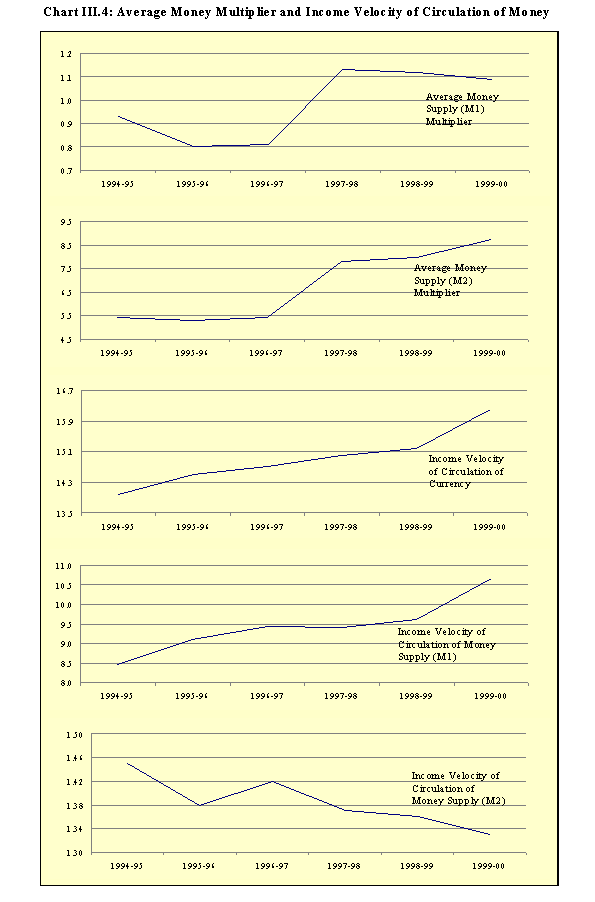
Table III.6 gives
details on the income velocity of circulation of money for the years 1993-94
through 1999-00. Chart III.4 shows the
average money multiplier and income velocity of circulation of money for the years
ended 1994-95 through 1999-00.
Commercial Banking Sector
Main Features
At the end of June 2000, ten domestic commercial banks were operating in Mauritius. Three of them are local banks, two foreign-owned but incorporated locally while the five others are branches of foreign banks. These ten banks were operating 145 branches, 15 counters, 1 mobile van, 221 Automated Teller Machines (ATMs), and employing 3,308 people. The number of inhabitants per branch decreased from approximately 8,449 at the end of June 1999 to 8,144 at the end of June 2000.
Several commercial banks offer card-based payment services such as credit and debit cards, and direct debits. Other facilities such as phone banking, home banking, internet banking and PC banking are also provided by some banks.
Between end-June 1999 and end-June 2000, total assets of commercial banks rose by 13.0 per cent, from Rs97,183 million to Rs109,866 million, compared to a rise of 16.8 per cent in the preceding year. Commercial banks' reserves, defined as their cash in hand and balances with the Bank of Mauritius, declined by Rs866 million, or 15.9 per cent, to Rs4,582 million in contrast to an increase of 39.0 per cent in the preceding year. Foreign assets of commercial banks rose by 6.3 per cent to Rs10,294 million over the same period, down from an increase of 36.2 per cent in 1998-99. Foreign bills purchased and discounted increased by 103.8 per cent to Rs2,404 million while balances with banks abroad decreased by 20.8 per cent to Rs822 million.
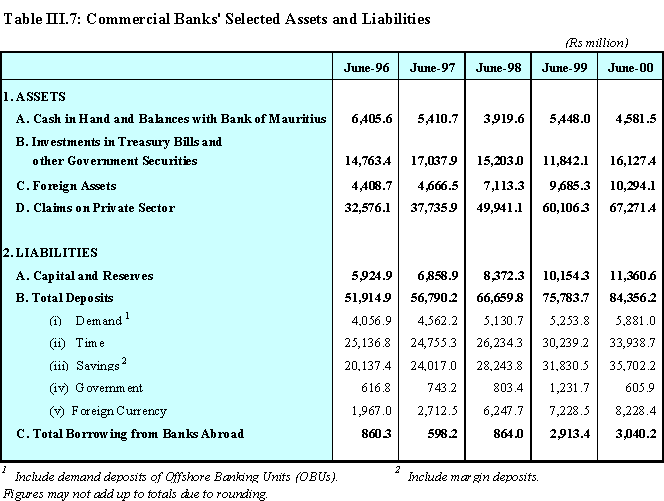
Commercial banks'
claims on government expanded by 35.2 per cent to Rs16,128 million at the end
of June 2000 as against a decline of 22.3 per cent in the preceding year. Banks' investments in Treasury Bills and other
Government Securities went up by 36.2 per cent whereas advances to Government
fell by 99.0 per cent.
Commercial banks'
credit to the private sector grew by 11.9 per cent, from Rs60,106 million at
the end of June 1999 to Rs67,271 million at the end of June 2000 compared to an
increase of 20.4 per cent in 1998-99.
The credit-deposit ratio of commercial banks increased from 79.3 per
cent at the end of June 1999 to 79.7 at the end of June 2000.

Total deposits with
commercial banks went up by 11.3 per cent, from Rs75,784 million at the end of
June 1999 to Rs84,356 million at the end of June 2000. Demand deposits rose by 11.9 per cent over
the same period compared to an increase of 2.4 per cent in 1998-99. Time deposits grew by 12.2 per cent, lower
than the 15.3 per cent growth recorded in 1998-99. Savings deposits expanded by 12.2 per cent, slightly down from
the growth of 12.7 per cent registered in 1998-99. Government deposits dropped by 50.8 per cent in contrast to an
expansion of 53.3 per cent in 1998-99.
Foreign currency deposits increased by 13.8 per cent compared to a rise
of 15.7 per cent in the preceding year.
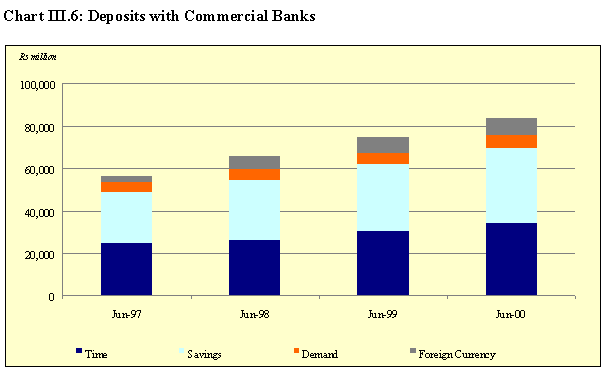
In comparison to
end-June 1999, the shares of demand, time, savings and foreign currency
deposits in total deposits went up at the end of June 2000. They increased from 6.9 per cent, 39.9 per
cent, 42.0 per cent and 9.5 per cent, respectively, to 7.0 per cent, 40.2 per
cent, 42.3 per cent and 9.8 per cent, respectively
The average balance per demand, savings and time deposits account stood at Rs89,852, Rs26,421, Rs305,441, respectively, at the end of June 2000.
Foreign liabilities of commercial banks increased by 4.4 per cent, from Rs2,913 million at the end of June 1999 to Rs3,040 million at the end of June 2000 compared to a growth of 237.2 per cent in 1998-99. The increase in foreign liabilities was mostly driven by a rise in borrowings from banks abroad for on-lending in foreign currency in Mauritius. Capital and reserves of commercial banks grew by 11.9 per cent, from Rs10,154 million at the end of June 1999 to Rs11,361 million at the end of June 2000 compared to an increase of 21.3 per cent in the corresponding period of the preceding year.
Table III.7 and
Charts III.5 and III.6 provide details on selected assets and liabilities of
commercial banks.
Sectorwise Distribution of Credit to the
Private Sector
Commercial bank credit to the private sector expanded by Rs7,165 million, or 11.9 per cent, from Rs60,106 million at the end of June 1999 to Rs67,271 at the end of June 2000 compared to an increase of 20.4 per cent in the preceding year. The additional credit was principally directed towards Hotels and towards investments in shares and debentures, which constituted about 34 per cent and 26 per cent, respectively, of the increase in credit. Statutory and Parastatal Bodies (Rs1,446 million), the sugar industry (Rs598 million), Development Certificate Holders (Rs515 million), Financial Institutions (Rs347 million), Personal and Professional (Rs291 million), and Other Customers (Rs236 million) were the other sectors to which large amounts of credit were channelled. Credit to Traders recorded a drop of Rs825 million.
Credit to the sugar industry, including the Mauritius Sugar Syndicate, rose by Rs598 million from Rs3,437 million at the end of June 1999 to Rs4,035 million at the end of June 2000, or by 17.4 per cent, up from 11.7 per cent in 1998-99. As a result, the share of credit to the sugar industry in total private sector credit rose from 5.7 per cent to 6.0 per cent.
Credit to the manufacturing sector (EPZ, DC, Pioneer, Ex-Dc, and Other Industries and Manufacturers) grew by Rs610 million, or 4.9 per cent, from Rs12,489 million at the end of June 1999 to Rs13,098 million at the end of June 2000 compared to a rise of 2.3 per cent in the previous year. Additional credit to the EPZ represented 13.0 per cent of the increase in credit to the manufacturing sector compared to 35.9 per cent in 1998-99. The share of credit to manufacturing in total private sector credit fell slightly from 20.8 per cent at the end of June 1999 to 19.5 per cent at the end of June 2000.
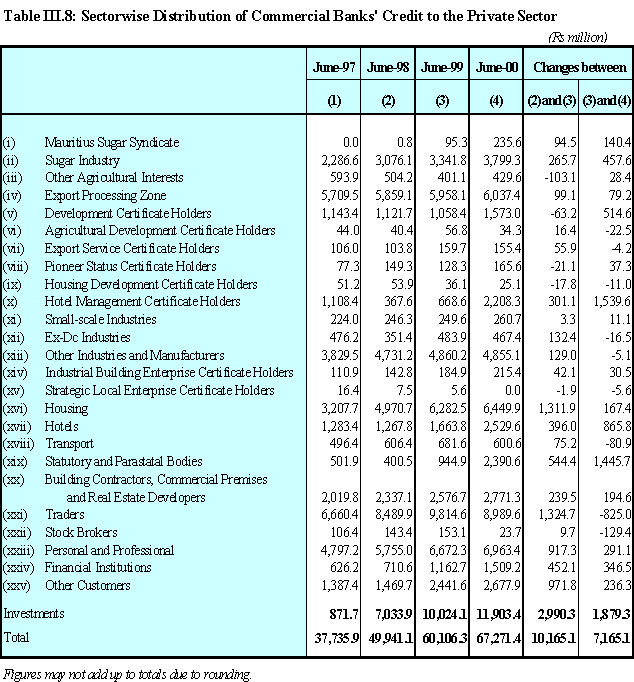
Credit to Traders
dropped by 8.4 per cent, from Rs9,815 million at the end of June 1999 to
Rs8,990 million at the end of June 2000 in contrast to a rise of 15.6 per cent
in 1998-99. At the end of June 2000,
credit to Traders represented 13.4 per cent of total credit to the private
sector, down from 16.3 per cent at the end of June 1999.
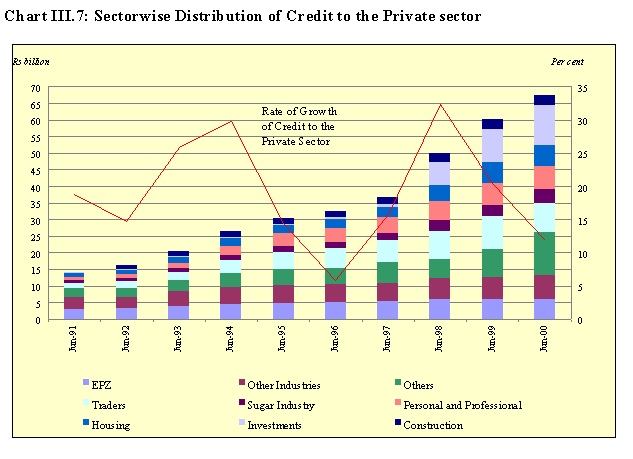
The growth rate
of credit to the construction sector (Housing Development Certificate Holders,
Industrial Building Enterprise Certificate Holders, Building Contractors,
Commercial Premises and Real Estate Developers) decelerated from 10.4 per cent
in 1998-99 to 7.7 per cent in 1999-00.
In absolute terms, credit to that sector increased by Rs214 million,
from Rs2,798 million at the end of June 1999 to Rs3,012 million at the end of
June 2000.
Credit for housing purposes rose by Rs167 million from Rs6,283 million at the end of June 1999 to Rs6,450 million at the end of June 2000, or by 2.7 per cent, down from 26.4 per cent registered in 1998-99. As a share of total credit, credit for housing purposes went down from 10.5 per cent at the end of June 1999 to 9.6 per cent at the end of June 2000.
Credit allocated to Hotels more than doubled, going up from Rs2,332 million at the end of June 1999 to Rs4,738 million at the end of June 2000. This represented a rise of Rs2,406 million, or 103.1 per cent, compared to 42.6 per cent in 1998-99. Its share in total private sector credit increased from 3.9 per cent at the end of June 1999 to 7.0 per cent at the end of June 2000.
Credit to the Personal and Professional sector increased from Rs6,672 million at the end of June 1999 to Rs6,963 at the end of June 2000, or by 4.4 per cent, down from 15.9 per cent registered in the preceding year. Its share in total private sector credit fell from 11.1 per cent at the end of June 1999 to 10.4 per cent at the end of June 2000.
Credit to the private sector by way of investments in shares and debentures increased from Rs10,024 million at the end of June 1999 to Rs11,903 million at the end of June 2000, or by 18.7 per cent, compared to a rise of 42.5 per cent in 1998-99. Investments in shares and debentures accounted for 17.7 per cent of total private sector credit at the end of June 2000, up from 16.7 per cent in 1998-99.
Table III.8 gives the breakdown of the sectorwise distribution of credit to the private sector from end-June 1997 to end-June 2000 while Chart III.7 shows its evolution from end-June 1991 to end-June 2000.
Maintenance of Cash Ratio by
Commercial Banks
Commercial banks are required to maintain a minimum weekly average cash reserve ratio of 5.5 per cent of their total deposit liabilities. The total deposit base of commercial banks includes both rupee deposits and the rupee equivalent of foreign currency deposits.
The monthly average cash ratio maintained by commercial banks in 1999-00 ranged from 5.6 per cent to 6.7 per cent compared to a monthly average cash ratio varying between 5.5 per cent and 8.4 per cent in 1998-99. From a trough of Rs4,322 million in the last week of July 1999, the average cash balances of commercial banks peaked at Rs5,396 million in the last week of December 1999, and thereafter, closed lower at Rs5,392 million at the end of the year.

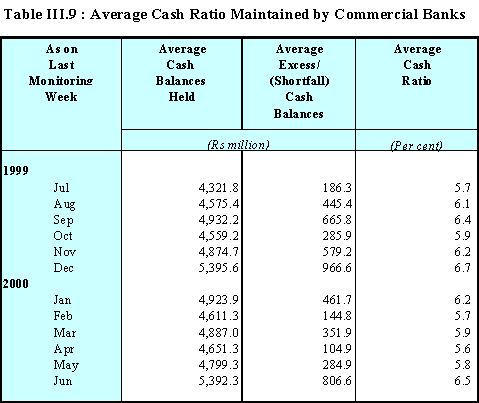
Weekly average excess cash balances held by commercial banks fluctuated widely between a minimum of Rs30 million in the first week of August 1999 and a maximum of Rs995 million during the third week of December 1999. In 1998-99, the weekly average excess cash balances had varied between Rs20 million and Rs2,001 million.
Table III.9 and Chart III.8 give details on the average cash ratio maintained by commercial banks in 1999-00.
Interbank Transactions
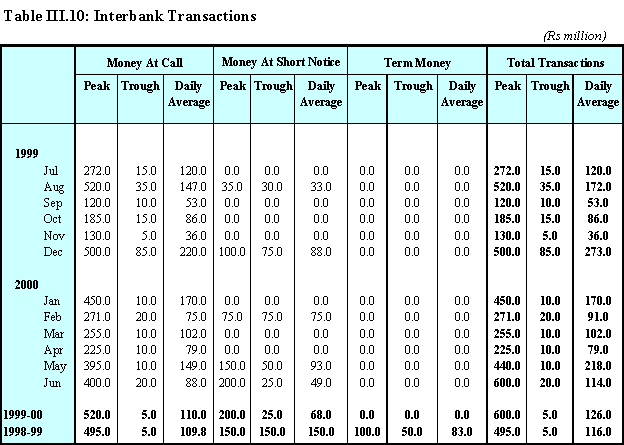
The money market is comprised of an interbank money market and a market for Treasury Bills. The interbank money market is a market for the short-term lending and borrowing of funds. Interbank transactions are carried out only among commercial banks at call (overnight), short notice (up to 7 days) and term (above 7 days). Commercial banks normally use the interbank money market to balance out their day-to-day cash and short money positions.
In 1999-00, interbank transactions remained concentrated in the call money market. The daily average amount of interbank transactions rose from Rs116 million in 1998-99 to Rs126 million in 1999-00. Around 49 per cent of total interbank transactions (representing a daily average of Rs123 million) were carried out in the first half of 1999-00 and the remaining 51 per cent (representing a daily average of Rs129 million) in the second half of the fiscal year. Total interbank transactions peaked at Rs600 million in June 2000 and came to a trough of Rs5 million in November 1999.
The daily average amount of call money transactions was almost unchanged at Rs110 million in 1999-00. However, the daily average amount of short money transactions fell from Rs150 million in 1998-99 to Rs68 million in 1999-00.
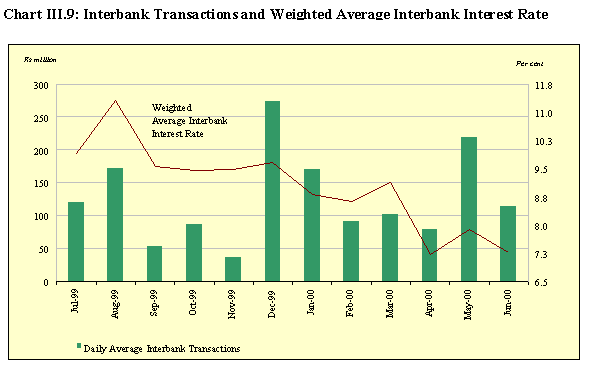
Interbank interest rates fluctuated within a narrower and slightly lower range of 5.00-15.00 per cent in 1999-00 compared to a range of 7.50-18.00 per cent in 1998-99. The weighted average interbank interest rate fell from 9.87 per cent in 1998-99 to 9.00 per cent in 1999-00. From a peak of 11.31 per cent in August 1999, the weighted average interbank interest rate reached a low of 7.20 per cent in April 2000 and closed the year at 7.27 per cent.
The weighted average call money interest rate declined from 9.76 per cent in 1998-99 to 8.94 per cent in 1999-00. Rates quoted on call money transactions varied between 5.00 per cent and 15.00 per cent. Rates quoted on short money transactions varied between 7.00 per cent and 12.75 per cent in 1999-00 compared to a uniform rate of 13.00 per cent in 1998-99. The weighted average short money interest rate dropped from 13.00 per cent in 1998-99 to 10.15 per cent in 1999-00.
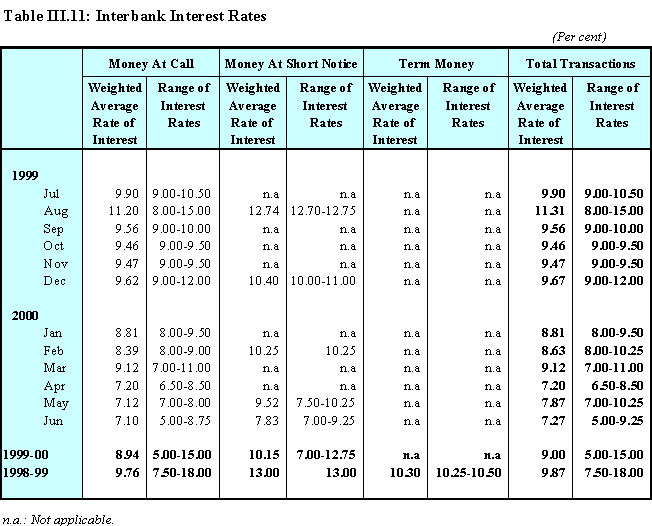
Tables
III.10 and III.11 as well as Chart III.9 give details on interbank transactions
and interbank interest rates in 1999-00.
Central Bank Credit to Commercial
Banks
As the lender of last resort, the Bank lent funds to commercial banks at its discretion in terms of both rate and volume up till 14 December 1999. As from 15 December 1999, the Bank introduced a standing facility, known as the Lombard Facility, to provide overnight collateralized advances to commercial banks. This facility is operated at the initiative of the commercial banks and gives them the necessary means and confidence to engage actively in treasury management function, such as repurchase transactions. The rate payable for use of this facility, the Lombard Rate, is used by the Bank as a signalling mechanism on its monetary policy stance.
For fiscal year 1999-00, recourse by banks to central bank overnight advances was limited to the months of July and August 1999, and May and June 2000.
Auctioning
of Treasury Bills
The Bank of Mauritius auctions Treasury Bills on a weekly basis. As from November 1999, 30-day Treasury Bills were replaced by 28-day Treasury Bills with the objective of aligning the maturity day of all Treasury Bills. As from the beginning of April 2000, the issue of 28-day Treasury Bills was discontinued.
During 1999-00, 53 auctions of Treasury Bills with 28/30-day, 91-day, 182-day, 364-day and 728-day maturity were held. A total amount of Rs61,750 million Treasury Bills was put on tender. Bids amounting to Rs52,328 million were received, of which a total amount of Rs44,231 million was accepted. The total amount of bids accepted represented 71.6 per cent of the tender amount and 84.5 per cent of the total amount of bids received. During 1999-00, the Secondary Market Cell (SMC) of the Bank underwrote Treasury Bills amounting to Rs12,106 million at primary auctions.
Participants showed a preference for 28/30-day and 91-day Treasury Bills, which represented 59.9 per cent of total bids received in 1999-00. The share of commercial banks' bids in total bids received went up from 49.5 per cent in 1998-99 to 58.5 per cent in 1999-00. Correspondingly, the share of bids from non-bank financial institutions in total bids received declined from 50.5 per cent in 1998-99 to 41.5 per cent in 1999-00.
The overall weighted average yield on bids accepted declined steadily from 12.75 per cent in July 1999 to 11.99 per cent in February 2000. It then rose to 12.01 per cent in March 2000 before declining again to close the year at 9.97 per cent. The overall weighted average yield for the fiscal year 1999-00 went up by 24 basis points to 12.00 per cent, from 11.76 per cent in 1998-99.
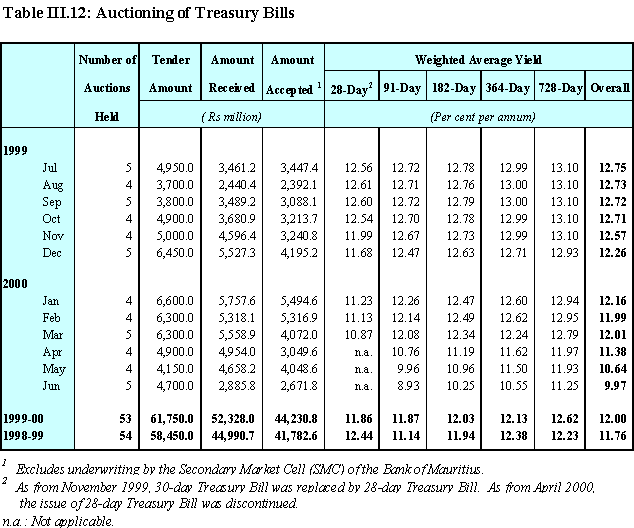
.
The weighted average yield on 28/30-day Treasury Bills went up from 12.56 in July 1999 to 12.61 per cent in August 1999 before declining gradually to reach a minimum of 10.87 per cent in March 2000. The weighted average yield on 28/30-day Treasury Bills went down by 58 basis points, from 12.44 per cent in 1998-99 to 11.86 per cent in 1999-00
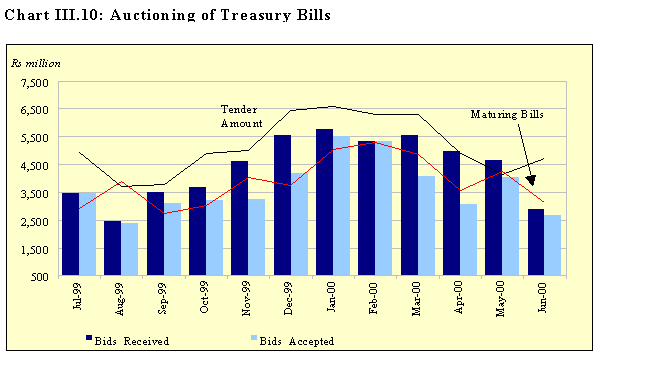
The weighted average yield on 91-day Treasury Bills fluctuated between 12.71 per cent and 12.72 per cent between July 1999 and September 1999. It, thereafter, declined steadily to reach 8.93 per cent in June 2000. The weighted average yield on 91-day Treasury Bills went up by 73 basis points, from 11.14 per cent in 1998-99 to 11.87 per cent in 1999-00.
The weighted average yield on 182-day Treasury Bills declined from 12.78 per cent in July 1999 to 12.76 per cent in August 1999 before rising to 12.79 per cent in September 1999. Thereafter, it fell to 12.47 per cent by January 2000, picked up to 12.49 per cent in February 2000 before declining again to close the year at 10.25 per cent. The weighted average yield on 182-day Treasury Bills was up at 12.03 per cent in 1999-00 from 11.94 per cent in 1998-99.
Charts
III.11: Weighted Average Yields on Treasury Bills at Primary Auctions
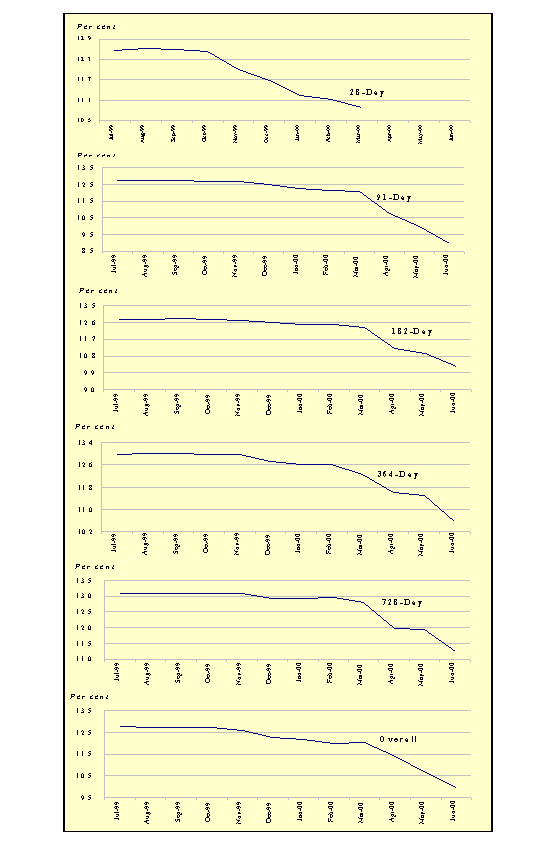
The weighted average yield on 364-day Treasury Bills fluctuated between 12.71 per cent and 13.00 per cent during the first half of the fiscal year 1999-00. From January to March 2000, it moved within a range of 12.24 per cent to 12.62 per cent before decreasing steadily to reach a low of 10.55 per cent in June 2000. The weighted average yield on 364-day Treasury Bills declined by 25 basis points, from 12.38 per cent in 1998-99 to 12.13 per cent in 1999-00.
The weighted average yield on 728-day Treasury Bills remained at 13.10 per cent between July 1999 and November 1999. It went down to 12.93 per cent in December 1999, but picked up slightly to 12.95 per cent in February 2000. Thereafter, it went on a steady decline to close the year at 11.25 per cent. The weighted average yield on 728-day Treasury Bills went up by 39 basis points, from 12.23 per cent in 1998-99 to 12.62 per cent in 1999-00.
The spreads between the shorter maturity and longer maturity Treasury Bills widened throughout the year 1999-00. The spread between the 728-day Treasury Bills and 28/30-day Treasury Bills grew from 0.54 percentage point in July 1999 to 1.92 percentage points in March 2000. Likewise, the spread between 728-day Treasury Bills and 91-day Treasury Bills widened from 0.38 percentage point in July 1999 to 2.32 percentage points in June 2000.
Table III.12 and
Charts III.10 and III.11 give detailed information on the auctioning of
Treasury Bills in 1999-00.
Secondary Market Activity
Activity on the secondary market for Treasury Bills picked up considerably in 1999-00. Transactions on the over the counter market on a first come first served basis of Government of Mauritius Treasury Bills to individuals and non-financial corporations were a dominant feature of secondary trading. These sales of Bills over the counter have strengthened the conduct of open market operations by the Bank of Mauritius, thereby improving the efficacy of monetary policy.
The total amount of Treasury Bills transacted outside the Secondary Market Cell (SMC) of the Bank declined by Rs1,127 million to Rs758 million in 1999-00 and accounted for 4.7 per cent of total secondary market activities compared to 16.5 per cent in 1998-99. More than 82 per cent of the total transactions outside the SMC were effected in the first half of the fiscal year 1999-00 compared to some 63 per cent in 1998-99.
Exclusive of Treasury Bills underwritten at primary auctions, the total amount of Treasury Bills purchased by the SMC more than doubled in 1999-00, going up from Rs1,181 million in 1998-99 to Rs2,760 million. Around 70 per cent of purchases, representing an amount of Rs1,920 million, were made in the first half of the year. Purchases started from a trough of Rs1 million in July 1999 before reaching a peak of Rs570 million in September 1999.
Treasury Bills sold by the SMC amounted to Rs12,494 million in 1999-00 compared to Rs8,380 million in 1998-99, representing a rise of Rs4,114 million or 49.1 per cent. Highest sales of Rs2,468 million were recorded in November 1999 while the lowest sales, amounting to Rs184 million, took place in May 2000.
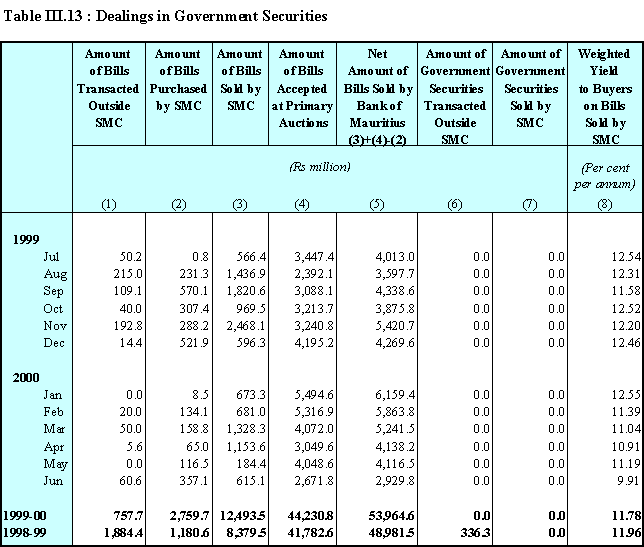
.
Net sales of Treasury Bills by the Bank of Mauritius at both primary auctions and on the SMC went up by Rs4,983 million, or 10.2 per cent, to Rs53,965 million in 1999-00. Of these, net sales by the SMC accounted for 18.0 per cent compared to 14.7 per cent in 1998-99.
The overall weighted yield to buyers on Treasury Bills sold by the SMC declined by 18 basis points, from 11.96 per cent in 1998-99 to 11.78 per cent in 1999-00. During 1999-00, no transactions in other Government securities were conducted by the SMC.
Table III.13
gives details on dealings in Government securities during 1999-00.
Repurchase Transactions
With a view to promoting efficient short-term liquidity management in the market, the Bank of Mauritius conducted, as from 15 December 1999, through an auctioning process and at its own initiative, short-term repurchase transactions (repos) and reverse repurchase transactions (reverse repos) as and when required in the light of prevailing liquidity conditions. Under a repo, the Bank of Mauritius supplies liquidity to the market by purchasing eligible securities from commercial banks with the agreement to resell them at a given future date and at a predetermined price. Under a reverse repo, the Bank of Mauritius absorbs liquidity from the market by selling eligible securities to commercial banks with the agreement to repurchase them at a given future date and at a predetermined price.
During 1999-00, reverse repurchase transactions were held on 14 occasions. Bids were called for a total amount of Rs4,800 million. Bids amounting to Rs6,830 million were received, of which a total amount of Rs4,340 million was accepted. The total amount of bids accepted accounted for 90.4 per cent of the total amount for which bids were called, and for 63.5 per cent of the value of total bids received. The repurchase periods varied from 1 to 7 days. The weighted average reverse repo rate declined steadily from 8.79 per cent in December 1999 to 6.95 per cent in April 2000. It went up to 7.06 per cent in May 2000 before falling to 6.35 per cent in June 2000. The weighted average repo rate for the year 1999-00 was 7.72 per cent.
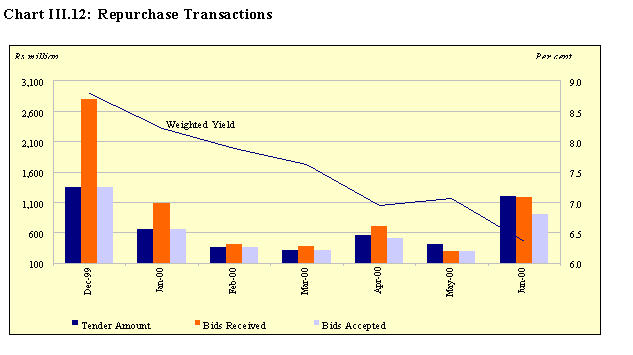
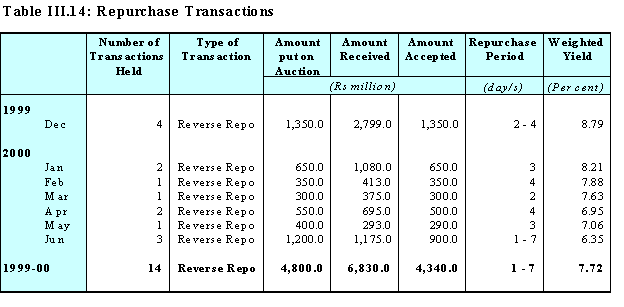
Table III.14 and
Chart III.12 provide details on the reverse repurchase transactions carried out
in 1999-00.
Interest Rates
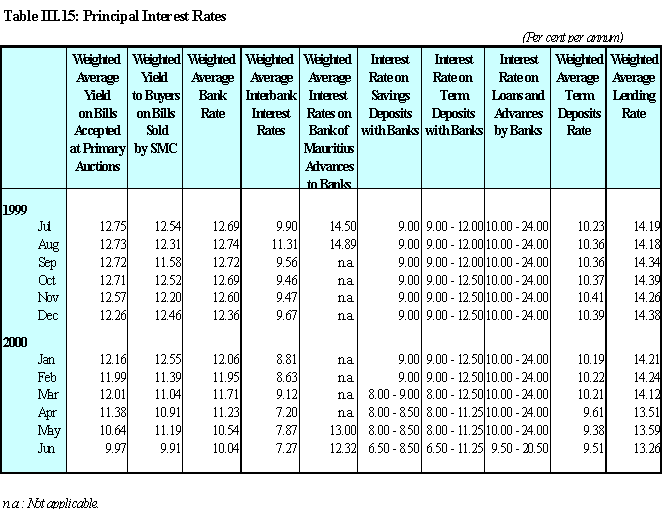
On 15 December 1999,
the Bank of Mauritius introduced the Lombard Facility in order to provide
collateralized advances to commercial banks.
The Bank announced that the Lombard Rate, which is the rate payable for
use of this facility, would be used as a signalling mechanism for its monetary
policy stance. The Lombard Rate, which
was initially set at 14 per cent, was reduced to 13 per cent on 22 March 2000
and further to 11.50 per cent on 20 June 2000.
The drops in the Lombard Rate were reflected in commercial banks'
interest rate structure.
In line with the reduction in the
Lombard Rate in March 2000, some commercial banks reacted promptly, bringing
down their savings deposits rate from 9.00 per cent to 8.00 per cent. Thus, in March 2000, interest rates on
savings deposits fluctuated within a band of 8.00 per cent and 9.00 per
cent. By April 2000, all commercial
banks had adjusted their interest rate on savings deposits, which then varied
between 8.00 per cent and 8.50 per cent.
With the second reduction in the Lombard Rate, savings deposits rates
went down again, varying between 6.50 per cent and 8.50 per cent at the end of
June 2000, as only a few commercial banks had by then factored in the lowering
of the Lombard Rate. The remaining
banks reduced their savings deposits rate to 6.50 per cent as from 1 July 2000.
Interest rates on longer-term
deposits went up from 12.00 per cent to 12.50 per cent in October 1999. They remained at that level until March 2000
and were brought down to 11.25 per cent as from April 2000. For shorter-term deposits, interest rates
remained at 9.00 per cent until February 2000.
They were lowered to 8.00 per cent in March 2000 and further down to
6.50 per cent in June 2000.
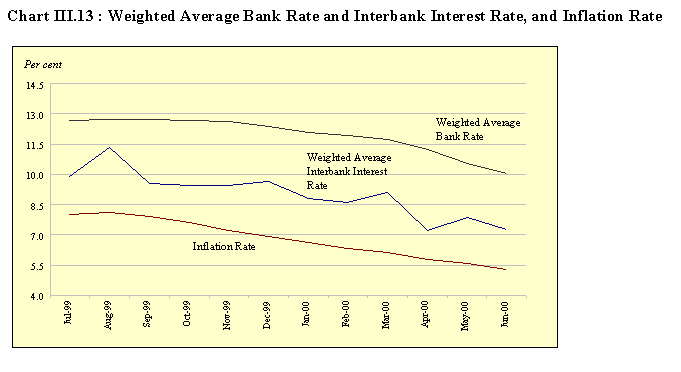
Commercial banks also adjusted their prime
lending rates according to the Lombard Rate.
Prime lending rates went down by one percentage point, from a range of
12.00-13.00 per cent in February 2000 to 11.00-13.00 in March 2000 and 11.00-12.00
per cent in April 2000, following the first reduction in the Lombard Rate. They were again adjusted downwards with the
second reduction in the Lombard Rate, varying between 10.00 per cent and 12.00
per cent at the end of June 2000 and between 10.00 per cent and 11.50 per cent
as from 1 July 2000.
Interest rates charged by commercial banks on
loans and advances ranged from 10.00 per cent to 24.00 per cent throughout
1999-00, except for June 2000 when the range dropped to between 9.50 per cent
and 20.50 per cent.
The weighted average term deposit
rates of commercial banks came down from a high of 10.41 per cent in November
1999 to a low of 9.38 per cent in May 2000.
The weighted average lending rate charged by commercial banks reached a
peak of 14.39 per cent in October 1999 and a trough of 13.26 per cent in June
2000.
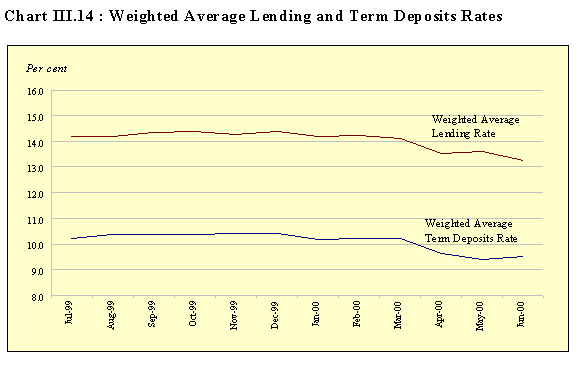
The spreads between the weighted
average term deposit rate and the weighted average lending rate were lower in
1999-00 than in the preceding year.
They varied between 3.8 percentage points and 4.2 percentage points in
1999-00 whereas they moved within a range of 4.0 percentage points to 4.6
percentage points in 1998-99.
The weighted average yield on
Treasury Bills sold on the primary market declined steadily from 12.75 per cent
in July 1999 to 11.99 per cent in February 2000. It rose to 12.01 per cent in the subsequent month before going
down again and closing the year at 9.97 per cent. In line with that movement, the Bank Rate was also on a declining
trend in 1999-00. It initially went up
from 12.69 per cent in July 1999 to 12.74 per cent in August 1999 but
thereafter, declined steadily to reach 10.04 per cent in June 2000. The weighted average yield to buyers on
Treasury Bills sold by the Secondary Market Cell (SMC) went down from 12.54 per
cent in July 1999 to 9.91 per cent in June 2000.
The weighted average interbank
interest rate went up from 9.90 per cent in July 1999 to a peak of 11.31 per
cent in August 1999. It reached a
trough of 7.20 per cent in April 2000 before closing the year at 7.27 per
cent. The spread between the weighted
average interbank interest rate and the Bank Rate generally varied within a
range of 2.6 percentage points to 3.3 percentage points except for a low of 1.4
percentage points in August 1999 and a high of 4.0 percentage points in April
2000.
Commercial banks sought advances
from the Bank of Mauritius in the first and last two months of the fiscal year
1999-00. The weighted average interest rate
on Bank of Mauritius advances to commercial banks rose from 14.50 per cent in
July 1999 to 14.89 per cent in August 1999.
In line with the introduction of the Lombard Rate in December 1999 at
14.00 per cent and its subsequent reductions to 13.00 per cent in March 2000
and 11.50 per cent in June 2000, the weighted average interest rate on central
bank advances came down to 12.32 per cent in June 2000.
Table
III.15 and Charts III.13 and III.14 give details on the interest rate structure
of the banking sector.
Capital Market Developments
Stock Exchange of Mauritius
The Stock Exchange of Mauritius (SEM) started its operations in July 1989. Initially, five companies with a market capitalisation of Rs1.1 billion were listed on the official market of the SEM. At the end of June 2000, 48 companies (including debenture and foreign listing) were listed on the Official Market with a market capitalisation of Rs39.3 billion. On 29 December 1999, the shares of the Delphis Bank were quoted for the first time on the Official list of the SEM while those of Lazard Birla India Investment Trust PLC (the company) were withdrawn from the Official List on 24 March 2000. The debentures of Harel Frères Ltd were traded for the first time on the Official list on 17 April 2000.
The SEM-7, which was introduced on 30 March 1998, is an index that measures movements in the 7 largest eligible shares on the official list in terms of capitalisation, liquidity and investibility. The composition of the SEM-7 changed 3 times during 1999-00, with the last change being effected on 6 April 2000. As at 30 June 2000, the composition of the SEM-7 was as follows: State Bank of Mauritius Ltd, The Mauritius Commercial Bank Ltd, New Mauritius Hotels Ltd, Sun Resorts Ltd, Rogers & Co. Ltd, Air Mauritius Ltd, and Ireland Blyth Ltd.
During 1999-00, there were 254 trading sessions on the Official Market with the aggregate value of transactions amounting to Rs2.3 billion for a volume of 187.7 million shares and debentures transacted. The SEMDEX, the stock market index, fell from 467.15 at the end of June 1998 to 418.87 at the end of June 1999 and further down to 410.28 at the end of June 2000. The SEM-7 declined from 101.49 on 30 June 1999 to 99.19 on 30 June 2000. The SEMDEX and the SEM-7 reached their peaks of 440.19 on 14 January 2000 and 106.51 on 17 December 1999, respectively. Both the SEMDEX and the SEM-7 hit their all-year lows of 390.10 and 93.76, respectively, on 13 August 1999. The turnover recorded on the Over-the-Counter (OTC) Market for shares amounted to Rs357.4 million for a volume of 53.4 million shares transacted during the 103 sessions held in 1999-00.

The share capital
of the SEM was opened up in April 2000 with a view to promoting greater
transparency in the running of the Exchange.
The eleven stockbroking companies, which held 100 per cent of the share
capital of the SEM, sold 52.53 per cent of their shareholdings to some key
players of the financial and business landscape in Mauritius. The number of shareholders thus increased
from 11 to 25. The new shareholders
would be called upon to play a leading role in the development of the stock
exchange and of the financial services sector in Mauritius.
The Stock Exchange Commission (SEC) approved new listing rules reflecting international standards and practices on 25 February 2000. These rules aim at improving corporate governance, disclosure and compliance requirements, thereby making the market more attractive to investors. These new rules meet the standards defined by the International Organisation of Securities Commission (IOSCO). The listing function was conferred upon the SEM. These rules will become effective on 1 February 2001.
The SEC is also working on rules that would govern the Compensation Fund to demonstrate its concern for and commitment to investor protection. The publication of a code of practice is yet another priority on the SEC's agenda for the coming months. The SEM is on the verge of finalising other major projects in the coming months, expecting fund managers to reassess opportunities on the market. The other major project, which concerns the automation of the trading system, is on track. The new trading infrastructure is expected to improve and modernise the securities trading environment and increase the depth and breadth of the market.
Investment
effected by foreign investors on the SEM decreased from a net outflow of
Rs345.9 million in 1998-99 to a net outflow of Rs227.0 million in 1999-00.
Chart III.15
shows the movements in the SEMDEX and SEM-7 during 1999-00.
Non-Bank
Financial Intermediaries
Development Bank of Mauritius (DBM)
The Development Bank of Mauritius (DBM) provides medium and long-term financing facilities to various sectors of the economy, such as agriculture, fishing, construction, tourism, textiles, other manufacturing, and transport. Furthermore, it provides financial support to educational institutions to upgrade their infrastructure, to individuals under the energy saving scheme, the computer scheme and the Information Technology Financing Scheme, to religious bodies for reconstruction and renovation of their edifice, and to various other sectors.
The total assets of the DBM amounted to Rs4,600 million at the end of June 2000, up from Rs4,393 million at the end of June 1999. The equity holdings of the DBM rose slightly from Rs59.2 million at the end of June 1999 to Rs59.5 million at the end of June 2000. Total loans disbursed by the DBM increased from Rs894 million at the end of June 1999 to Rs1,032 million at the end of June 2000.
Post Office Savings Bank (POSB)
The POSB mobilises savings primarily from small depositors in the country. It invests in Government securities and extends loans to the Mauritius Civil Service Mutual Aid Association. Total assets of the POSB went up from Rs723 million at the end of June 1999 to Rs810 million at the end of June 2000. Total savings deposits mobilised by the POSB rose from Rs556 million at the end of June 1999 to Rs645 million at the end of June 2000. Its investments in Government papers declined from Rs173 million at the end of June 1999 to Rs160 million at the end of June 2000, while loans to the Mauritius Civil Service Mutual Aid Association went up from Rs538 million to Rs630 million over the same period.
The National Pensions Fund (NPF)
The NPF, which is one of the largest
non-bank financial intermediaries in Mauritius, consists of contributions made
to the National Pensions Scheme by employees and employers both in the public
and private sectors. The total
investment portfolio of the Fund increased from Rs14.9 billion at the end of
June 1999 to Rs16.9 billion at the end of June 2000. The NPF invested Rs10.1 billion in Government securities at the
end of June 2000 compared to Rs9.6 billion at the end of June 1999. Total loans disbursed by the NPF at the end
of June 2000 amounted to Rs2.3 billion compared to Rs1.4 billion in the
previous fiscal year.
Deposit-Taking Leasing Companies
The number of deposit-taking leasing companies went up from 5 at the end of June 1999 to 6 at the end of June 2000. Debentures issued by the deposit-taking leasing companies rose by 13.0 per cent, from Rs2,170 million at the end of June 1999 to Rs2,452 million at the end of June 2000 while deposits mobilised from the public went up from Rs139 million to Rs344 million. Borrowings of deposit-taking leasing companies from commercial banks increased from Rs219 million at the end of June 1999 to Rs303 million at the end of June 2000 while their borrowings from Bank of Mauritius dropped from Rs575 million to Rs239 million. Their claims on the private sector by way of loans, advances, leases and investments in shares and securities rose by 12.4 per cent, from Rs2,918 million to Rs3,279 million. Their investments in Government securities fell from Rs514 million to Rs249 million over the same period. Total assets of the deposit-taking leasing companies rose by 7.5 per cent, from Rs3,605 million at the end of June 1999 to Rs3,877 million at the end of June 2000.
The State Investment Corporation Ltd
(SIC)
The SIC, as the investment arm of the Government of Mauritius, manages the investment portfolio of the Government in the private sector. It finances existing enterprises as well as new ventures in the industrial, tourism, agriculture, commercial and financial sectors. Total investments of the SIC rose considerably from Rs2,249.5 million at the end of June 1998 to Rs2,756.3 million at the end of June 1999 while its total assets went up from Rs2,403.8 million to Rs2,986.9 million.
Investment Companies
As at end June 2000, there were also around 20 investment companies in Mauritius, involved in activities of mutual fund, unit trusts, closed-ended funds and venture capital.